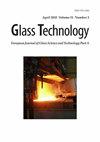Drone Equipment and Configuration for Crude Oil Spill Detection in Water
IF 0.3
4区 材料科学
Q4 MATERIALS SCIENCE, CERAMICS
Glass Technology-European Journal of Glass Science and Technology Part a
Pub Date : 2022-07-19
DOI:10.47672/ejt.1127
引用次数: 1
Abstract
Purpose: The objectives of this article was to outline the various equipment and configuration of drones which can be used to detect and support oil spill response in water. The study aimed at identify the type of sensors that can be mounted on drones for effective crude oil spill detection in water. Methodology: A systematic review of past articles on drones in disaster management was done. In this article, various parts of drone and configuration was tested. Sensors capable of detecting crude oil in the visible, infra-red, near infrared, laser fluoro-sensor were elaborated. Findings: A drone can properly be used for oil spill response operations. Appropriate sensors mounted on the drone can detect oil spill in water and can also access locations which are not readily accessible to large ships and other aerial patrol platform. The limitation of drones is the payload capability and its inability to operate well in windy weather. Recommendation: Since data collection with drone are faster, cheaper and easier during an oil spill response operations, it is highly recommended to mount the suitable sensor capable of detecting oil sheen even during nighttime operations.水下原油泄漏检测无人机设备及配置
目的:本文的目的是概述可用于检测和支持水中溢油响应的无人机的各种设备和配置。这项研究旨在确定可以安装在无人机上的传感器类型,以便有效地检测水中的原油泄漏。方法:系统地回顾了过去关于无人机在灾害管理中的文章。在本文中,对无人机的各个部分和配置进行了测试。阐述了可用于原油探测的可见光、红外、近红外、激光荧光传感器。研究发现:无人机可以适当地用于溢油响应作业。安装在无人机上的适当传感器可以检测水中的溢油,也可以进入大型船只和其他空中巡逻平台不易进入的位置。无人机的局限性在于有效载荷能力和在大风天气下无法正常运行。建议:由于在溢油响应作业中使用无人机收集数据更快、更便宜、更容易,因此强烈建议安装合适的传感器,即使在夜间作业中也能检测到油光。
本文章由计算机程序翻译,如有差异,请以英文原文为准。
求助全文
约1分钟内获得全文
求助全文
来源期刊
CiteScore
0.30
自引率
0.00%
发文量
0
审稿时长
>12 weeks
期刊介绍:
The Journal of the Society of Glass Technology was published between 1917 and 1959. There were four or six issues per year depending on economic circumstances of the Society and the country. Each issue contains Proceedings, Transactions, Abstracts, News and Reviews, and Advertisements, all thesesections were numbered separately. The bound volumes collected these pages into separate sections, dropping the adverts. There is a list of Council members and Officers of the Society and earlier volumes also had lists of personal and company members.
JSGT was divided into Part A Glass Technology and Part B Physics and Chemistry of Glasses in 1960.

 求助内容:
求助内容: 应助结果提醒方式:
应助结果提醒方式:


